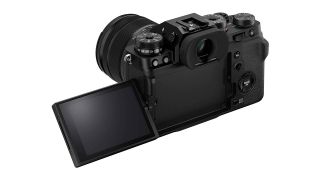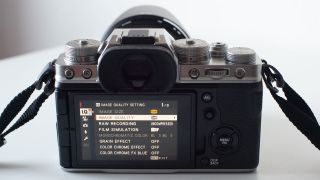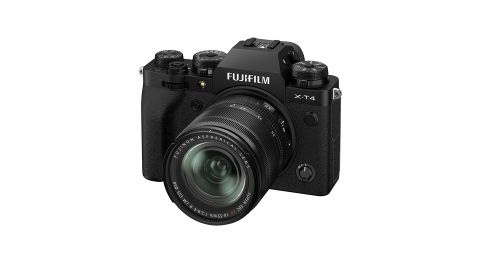Space Verdict
The Fujifilm X-T4 offers great value, excellent ISO range, easy-to-use menus; it is also compact and lightweight.
Pros
- +
Lightweight, easy to use
- +
Multi-swiveling screen
- +
Great ISO range for low light
Cons
- -
Doesn’t come with battery charger, have to plug in whole camera
- -
Easy to forget to ‘lock’ the ISO and shutter speed dials
- -
Harder to see controls and settings in the dark
Why you can trust Space.com
The Fujifilm X-T4 is the latest high-end photo and video APS-C mirrorless camera from Fujifilm. The X series was created in response to the overly complicated and increasingly larger and heavier DSLR models that were dominating the market. The simplified functionality as well as the overall look and feel is designed to emulate a classic film camera. It has retro-style fingertip dials rather than an overly complicated digital menu yet it lacks none of the functionality you’re used to with a DSLR. With its extremely high ISO capability and handy screen display, coupled with Fujifilm’s long history of making high-quality optics, it makes for an ideal choice for nighttime and astrophotography.
Fujfilm X-T4 camera review: Design
- Fully adjustable screen
- Handles like a film camera
- Good range of dials for easy adjusting
The overall design of the Fujifilm X-T4 camera body is sleek, slim and so easy to handle you won’t want to put it down. The brushed silver model looks exceptionally stylish and brings to mind old film cameras from a bygone era. Instead of wheels for altering the shutter and aperture with a digital display to chronicle them, this series sees the return of dials on the top of the camera body.
Type: Mirrorless
Sensor: 26MP
Lens mount: FUJIFILM X mount
ISO range: 160-12800 (with 80–51200 extended output)
Viewfinder size/resolution: 0.5 inch approx.
Video capability: 4K capture for around 30 minutes (20 minutes for frame rates above 30p)
Weight: 1.34 lbs (including battery and memory card)
Size: 5.2 x 3.65 x 2.5 in
Memory card: Type SD
The controls placing has been nicely thought out to enable easy access to the main functions while out in the field and on the go. On the left is a dial for the various drive modes – shooting, HDR, continuous (long and short), and bracketing – and is neatly combined with the ISO dial. There’s a sensitivity lock button on the top which allows you to lock in the ISO which will stop the dial from being rotated accidentally as you take the camera in and out of your bag. As a double backup, there’s even an angry noise that will sound when you press the shutter if you’ve accidentally got the setting completely wrong (although all audio can also be turned off). We discovered this while shooting on a bright sunny day with the ISO accidentally set to 12800!
The shutter speed is also controlled by a dial to the right of the viewfinder while the aperture is changed on the lens ring itself rather than a wheel or a button. Initially, the exposure compensation dial seems to take up quite a lot of space but in practice, it’s much more practical than having to go into a menu or combine it with pressing other buttons.

This makes the overall handling pretty intuitive once you get used to it. One drawback for night photography, however, is that unlike many digital cameras there’s no lit-up top screen that shows what settings you’re on. You can, of course see them through the viewfinder or on the screen but it’s not quite as easy to use in the dark (and less practical if you’re trying to preserve the battery life by switching the screen off), not to mention impossible to refer to if you forget mid-shot what exposure time you’re set to. This won’t pose a problem to the focused among you but for the likes of us who get easily distracted or whose concentration wanes by the time a 2am astro shoot rolls around, it would be handy to have a reminder. There is, however, a little red light that tells you the shot is in the process of being taken.
The X-T4 is remarkably lightweight for a pro-level camera and even with the kit lens (16–80mm) or the 70–300mm lens, it almost feels like a toy camera. It’s a solid build despite its weight and certainly survived an accidental drop onto a gravel path without a scratch. It’s not fully waterproof but it will survive a bit of rain and damp conditions.
Fujfilm X-T4 camera review: Functionality
- Bluetooth enabled
- Connects to easy-to-use phone app
- Screen swivels through 270º axis
The Fujifilm X-T4 camera screen is equipped with touchscreen capability, however, it’s only meant for accessing the focus points. The screen swivels 270º on its axis and comes out a full 180º from the body so it’s pretty flexible for most situations you might find yourself in during an astro or night shoot. It’s particularly useful when you have the camera pointed upwards on a tripod as you will no doubt need to for shooting the stars.
For general menu use, you need to use the little joystick or the arrow keys (both work identically). You can also see the same screen through the viewfinder (which is a live view read off the sensor) – a clever sensor in the viewfinder surrounds tells the camera to return the screen to black and reveal the settings in the viewfinder instead.
The functions shown through the display and viewfinder are identical. A number of the settings overlay the image on the screen which can be distracting when lining up a shot and looking at the edges of the frame, but only the exposure compensation setting covers the image when looking through the viewfinder. However, it’s possible to change the display so you don’t have lots of info in the viewfinder/screen.

Because the camera handles like an old-school analog camera, there are no specific M (manual) A (Aperture priority) S (shutter priority), and P (program) modes. For a fully auto experience, you can set the ISO, shutter speed, and aperture all to A or take them off the A setting accordingly, depending on what level of control you want over your shot. This makes it easier for nighttime photography when you’re likely to need to alter the settings according to the specific light levels in your shot.
It has two memory card slots, each taking standard SD cards, which means you can simultaneously shoot RAW and jpeg and save them on different cards if you want to keep them separate. There are advantages of shooting both RAW and jpeg when using some of the processing features like film simulation (which is dealt with later), plus you need to shoot jpegs if you want to use the iPhone app interface.

There’s a phone app (Cam Remote) that connects your Fujifilm X-T4 to your phone via Bluetooth, which allows you to use the phone for live view, as a remote shutter release, and to download jpeg versions of the images to your phone’s image library. It’s worth noting that you have to set the camera to shoot in both RAW and jpeg for this to work and this is something we discovered by erm... Shooting only in RAW and wondering where all the pictures were. It has a number of controls that can be altered on the app – exposure compensation, ISO film simulation, white balance, and self-timer.
This neatly solves the problem of there not being a lit-up screen with the settings on it that makes it harder to see controls and settings in the dark when doing night photography but it does somewhat deplete the battery of both your camera and phone. Unless you grossly over or underexpose the shot or it’s clearly out of focus, you can’t really judge based on the screen view. For example, the image will contain much more highlight detail than can ever be shown on the screen.

There’s a ‘Q’ menu button on the right-hand side which is useful for quick access to the menu of 16 of the shooting functions including image size, white balance, image quality, and film simulations as well as any custom settings you may wish to create. Although the main menu itself is pretty easy to navigate, we found this really useful, especially for altering the white balance and trying the different film simulations.
As for integration with peripheral products, there’s an extensive range of high-quality prime and zoom lenses that fit the X-T4. The 70–300mm is a particularly good option. The tripod screw connector is standard and will fit all standard tripods.
Fujfilm X-T4 camera review: Performance
- Amazing ISO capabilities
- Great in-body image stabilization
- Film simulation options
The Fujifilm X-T4 performs exceptionally well at low light and night time conditions. The ISO goes up to a staggering 51200 using the ‘command’ setting. We tested up to 12800, at which point the graininess became too apparent, though with a little tweaking in Lightroom afterwards, this was largely controlled with some luminance smoothing and noise reduction. For night sky shooting, anything higher than that would detract from the clarity of the stars.
Kit lens: 16–80mm
Best zoom lens: 70–300mm
Spare battery type: NP-W235
Memory card: SD
The camera comes equipped with 12 film simulation modes, designed to emulate the look and feel of the most popular of Fuji’s film stocks. Among the simulations included, Velvia is designed for enhancing bright colors and is great for landscapes and looks especially good on the blues of the night sky. These modes are great fun to play with, but given that they’re only simulations placed on top of the jpeg processing, they’re of little use if you’re shooting RAW. They’re great if you want to bluetooth the jpeg to your phone and share them immediately on social media but, if you’re a more of a purist and RAW shooter, it feels rather more gimmicky than useful to astro and night sky photography.

The Color Chrome FX blue is another feature that will make your blue hour skies pop but you can create just as effective results from using the Tungsten or degrees Kelvin (K) setting in white balance. The white balance is applied to the RAW files whereas the film simulation and Colour Chrome FX are only applied to the jpeg simulations [check claim for latter! I couldn’t work out from the shots].
There’s a dynamic range setting that allows you some control over contrast. This can be good for nighttime shots where there are bright lights and dark shadows which create big contrasts so long as you don’t overdo it; double the dynamic range is probably enough for dark skies.

The Fuji X-T4 uses the NP-W235 battery which has a CIPA rating of around 500 shots per charge in an everyday performance mode. In practice, this can be a lot higher if you’re shooting in the daytime, however with the kinds of long exposures you’ll need to do to capture the night sky, it will be somewhat lower.
The battery life is decent enough for a day or two of significant shooting. During the testing process, one evening’s blue hour shooting and early night sky long exposures (approximately an hour and a half in total) used up about 30% of the battery. One drawback, however, is that the kit doesn’t come with a battery charger; you need to plug the whole camera in to charge it. Although there’s the flexibility to charge it via USB as well as a wall socket, it does mean that unless you invest separately in a spare battery and charger you won’t be able to leave one battery on charge while out shooting all day.

Should you buy the Fujifilm X-T4 camera?
The Fujifilm X-T4 is a good option both for those who grew up with film photography and are used to the look, feel and functionality of a film camera as well as those who are new to digital photography. It offers a simplified digital experience, coupled with a solid build and features like the insanely high ISO and the swivel head screen that make astro- and night photography easier to achieve. For anyone considering upgrading from an old, heavy DSLR, it’s well worth making the switch.
If this product isn’t for you
Despite its relative affordability, the Fujifilm X-T4 is still quite an investment. If you're looking for a more affordable camera suited to astrophotography, we'd recommend the Canon EOS Rebel SL3. As well as being a great entry-level camera, the Rebel SL3 boasts an ideal screen for Live View shooting, and Canon lenses are relatively cheap.
If you're after a similar-priced model in the Nikon brand, we'd recommend looking at the Nikon Z6, which we've also tested and reviewed.
Join our Space Forums to keep talking space on the latest missions, night sky and more! And if you have a news tip, correction or comment, let us know at: community@space.com.
Diana is a photographer and writer based in Margate, Kent. She has shot many guidebooks for Rough Guides and undertaken numerous commissions for Visit England, National Geographic Traveller, GreenTraveller and Cool Camping, among others. She’s currently the editor of Eye for the Light a subscription-only, digital publication in association with Travel Photographer of the Year and the Sustainability and Photography Director at the British Guild of Travel Writers.

